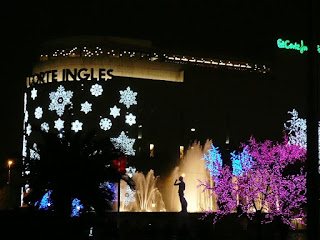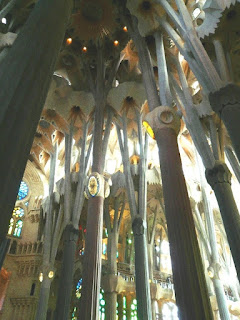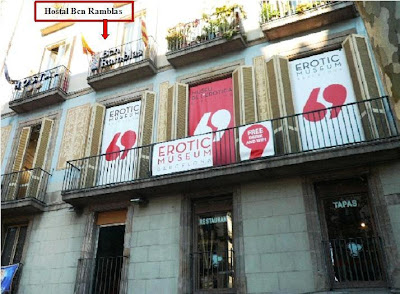The two cities are Copenhagen and Barcelona. We visited both in December--each just for a long weekend--and both were fantastic.
Copenhagen
I have lost track of the number of times I have been in Copenhagen, but for most of the past 45 years I have spent a few days or a week each year in Denmark. Most of those trips involved some time in its capital city. Through the years I have observed many changes but also watched with wonder that some things remain constant, or renew themselves to keep up with the times--and quite often that is done in an agreeable manner. In many ways, Copenhagen has become my barometer of change and constancy.
 |
| Lyngby Storcenter - a shopping center's Christmas village. ©Johannes Bjorner 2012 |
Surgery and rehabilitation kept us from travel earlier this year, so we decided to do the Denmark trip in early December, to celebrate a birthday and get into the Christmas spirit. It was a
very quick trip. We took an early Friday morning flight from Alicante and were in Copenhagen before lunchtime, and we were scheduled to return late Sunday evening. There was a time--and not too many years ago--when all the stores would have been closed Saturday afternoon and all day Sunday. That would have left us precious little time to scour the shops for books and DVDs and Christmas decorations and pass through the department stores to catch up with the trends. Fortunately times have changed and we had no trouble finding places to spend our money every hour that we were able to be out of our hotel.
 |
| Tivoli at Christmas, ©Johannes Bjorner 2012. |
It was cold, and it snowed on Sunday, but that didn't stop us. We came back with suitcases filled with 30 or more DVDs in the original English or Danish--something we cannot find in Spain, where films are routinely dubbed into Spanish in the cinemas, on TV, and on DVD. We went to at least four big bookstores and even waited in line for almost an hour for an author signing at one. We saw two current films in the theater--something we never do in Spain. We ate in our long-time favorite restaurant where we almost always enjoy a meal--usually the same
kro-platte selection of open-faced sandwiches, though the sandwiches change over the years and are as good a barometer of fiscal conditions as the McDonald's index. And of course we went to Tivoli. There it was frightfully cold, and the masses of people (we really should not have left this until Saturday evening) made us realize that we have turned into country bumpkins, unused to throngs of humanity in one place.
Barcelona
I don't have enough years left to get to know Barcelona the way I know Copenhagen. This--three days over Christmas--was my second trip and I recognized some of the places from
my first trip to Barcelona. That had been for a professional conference, however, and this trip was purely for pleasure.
 |
| Christmas Lights at Plaza Catalunya, ©Johannes Bjorner 2012 |
Did we think that we had left Christmas decorations behind us in Copenhagen? Not on your life! There may not be as many pine trees in Spain as there are in Scandinavia, but nowhere can there be more lights. We sat in the restaurant at the top of
El Cortes Inglés department store Christmas Eve as the day turned to dusk and saw the colorful street lights coming on all over
Plaza Catalunya at the top of the
Rambla. We also spied the fairly new Apple store on the other side of the plaza, so of course we had to walk in that direction when we moved on our way. On Christmas Eve at 8:00 PM the place was jumping. Though there were people playing at all 20 of the large tables with various devices arranged in the room, we had no trouble finding a geek to answer a few questions we had.
 |
| Looking Up at Sagrada Familia, ©Johannes Bjorner 2012 |
Earlier on Christmas Eve day we had made the pilgrimage to
Sagrada Familia cathedral, which we had first seen in 2009. At that time there was scaffolding in the sanctuary and construction dust all around. Since then, the Pope has been to Barcelona to consecrate the cathedral and while it is not done--and will not be done in my lifetime, probably--the scaffolding is gone and during the Christmas season, at least, there were no signs of construction. Work on the
Sagrada Familia began in 1882. There is something very nice about now having seen it twice, with construction workers, and with signs of progress. It provides a connection with the millions of people who, over the centuries, built other mammoth cathedrals in Europe. This one is extraordinarily beautiful and inspiring, regardless of your faith or lack of it.
 |
| Gaudi Tiled Bench in Park Guëll, ©Johannes Bjorner 2012 |
Christmas Day itself we had reserved for the Park Guëll, since most everything else would be closed on a public holiday, but, we reasoned, a park would not. The artist Gaudi lived in a house in the park for 20 years while he was designing the public park space; Guëll was his employer-benefactor. The weather had turned hazy and so we did not have the spectacular views of Barcelona that this high-elevation park normally provides, but we still enjoyed the walk through its winding and climbing pathways and the varied vegetation. We entered from a back entrance, we discovered (we had followed the directions of the information person at the Metro and Metro is
not the best way to go, we now know) and we had to walk all the way to the front entrance before finding the famed fountains and buildings and park benches with Gaudi's colored tiles.
We enjoyed many other things in Barcelona: the gorgeous displays of food at
La Boqueria market, just across from where we stayed on the
Rambla, and the best steak that I have had in nine years in Spain at
Restaurante Ferran, which is better known for tapas and Spanish cuisine--so we shared an appetizer of tomato bread with
jamón ibérico de bellota (which means that the contributing pigs have eaten only chestnuts). I walked to the end of the
Rambla and saw the Columbus statue and some Christmas market stalls, but I didn't buy anything, because enough is enough. We had a delightful interchange with a young Danish woman of Afghan-Indian heritage and her Indian
novio, who happened to be our host at the
hostal in which we stayed. They are going to India once her exams are over for this season--her first time in India--and we gave them Danish Christmas decorations we had brought with us and wish them the best of luck in their future life.
 |
| ©Johannes Bjorner 2012 |
And all this was made easier because we had a
hostal in a very central position on the
Rambla--just opposite the Liceu Metro exit. I had never stayed in an
hostal before, wary that it was a little too basic for my mature tastes, and thinking of bunk beds in dormitories. Our
hostal, however, was less than a year old and was quite modern, with comfortable beds and northern European comforters, a clean and functional toilet and shower, with the usual amenities, and the best lighting on both sides of the double bed that I have experienced in awhile. Yes, it was in an old building with a very narrow stairway that you had to go up even to get to the tiny elevator, certainly the smallest I have ever seen, and remember--I have been in Denmark. The elevator (which required a key) was limited to 150 kg., so balancing two pieces of luggage (even carry-on) and two people meant that inevitably one (or more) got left out. But most of the time, there were just two of us going up and down in the elevator, and all we had to remember to do in the tiny space was, as Johannes said, "Assume intimate position" and up (or down) we would go. All this was quite appropriate since we shared a building (but not the same entrance) with the Erotic Museum.

